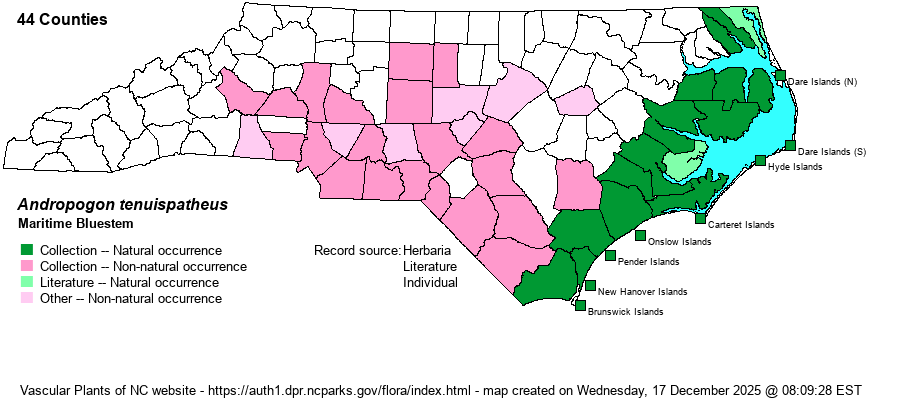| Section 5 » Family Poaceae |
Show/Hide Synonym
| taxonName | relationship | relatedTaxonName | relatedTaxonRefText | relComments |
|---|
|
| Andropogon tenuispatheus | = | Andropogon glomeratus var. pumilus | Flora of North America (1993b, 1997, 2000, 2002a, 2002b, 2003a, 2004b, 2005, 2006a, 2006b, 2006c, 2007a, 2009, 2010) | | | Andropogon tenuispatheus | = | Andropogon glomeratus var. pumilus | Kartesz (1999) | | | Andropogon tenuispatheus | = | Andropogon glomeratus var. pumilus | Wunderlin & Hansen Flora of Florida (3) | | | Andropogon tenuispatheus | = | Andropogon glomeratus var. pumilus | Weakley et al. (2011)=Y. Key adapted in part from Z. | ("robust variant") | | Andropogon tenuispatheus | < | Andropogon glomeratus | Hitchcock & Chase (Manual of US Grasses) | | | Andropogon tenuispatheus | < | Andropogon glomeratus | Small (1933, 1938) | | | Andropogon tenuispatheus | < | Andropogon virginicus | Radford, Ahles, and Bell (1968) | | | Source: Weakley's Flora |
|
| Author | (Nash) Nash | |
| Distribution | Native only to the outer Coastal Plain and Outer Banks. Spreading and adventive inland into most of the Piedmont. Not yet known from the northernmost Piedmont, northwestern Coastal Plain, or the Mountains. Its natural distribution is in the tidewater counties only. Inland, it is adventive along roads, highways, fallow fields, etc., especially where salted in winter.
Eastern VA, southeastern TN and OK, south to southern FL and southern TX. | |
| Abundance | Frequent to common in the outer Coastal Plain and Outer Banks as native populations. Frequent to locally abundant inland, especially along salted roadsides, and increasing in numbers and extent. | |
| Habitat | Natural habitats include brackish and fresh-tidal marshes, maritime wet grasslands, roadsides on barrier islands. In the past several decades it has aggressively colonized disturbed and wet places inland such as low roadsides, abandoned fields, and damp meadows. Never found in seepage slopes, pitcher-plant bogs, or Longleaf Pine savannas, where A. glomeratus occurs. |
| Phenology | Flowering and fruiting August-October. | |
| Identification | This species is very similar to A. glomeratus and even today many texts do not distinguish them. However, they differ in a number of ways, especially their native habitats. Maritime Bluestem has taller stems (2.5-5 feet), many more "heads" (3-11), and shorter ligules (usually less than 1 mm long vs. usually more than 1 mm long in A. glomeratus). Throughout most of the growing season, Maritime Bluestem's inflorescence has a pale green sheen to it, versus dull green or rust-tinged in Bushy Bluestem. | |
| Taxonomic Comments | In some texts treated as A. glomeratus var. pumilus. Older texts such as RAB (1968) did not even mention this taxon, as it and so many other bluestems at that time were sunken into the very large/broad A. virginicus label.
While the genus Andropogon is quite easy to recognize in the field, ID of species is not so easy and there are no shortcuts. Readers are strongly advised to read the introductory paragraphs in Weakley (2018) and to use his key. Once one has successfully keyed out several species, or compared collections with verified specimens, one can learn to recognize them in the field. | |
| Other Common Name(s) | Maritime Bushy Bluestem, Saltmarsh Bushy Bluestem | |
| State Rank | S5 | |
| Global Rank | G5T5 [G5] | |
| State Status | | |
| US Status | | |
| USACE-agcp | | |
| USACE-emp | | |

